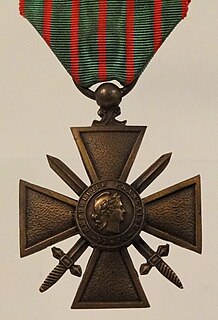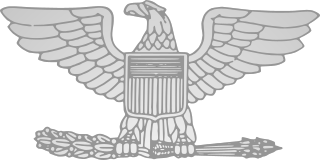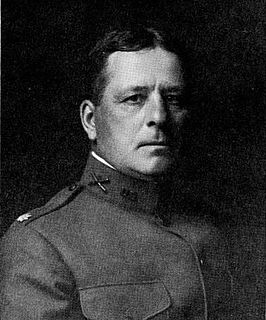Related Research Articles

The Distinguished Service Medal (DSM) is a military decoration of the United States Army that is presented to soldiers who have distinguished themselves by exceptionally meritorious service to the government in a duty of great responsibility. The performance must be such as to merit recognition for service that is clearly exceptional. The exceptional performance of normal duty will not alone justify an award of this decoration.

The Croix de Guerre is a military decoration of France. It was first created in 1915 and consists of a square-cross medal on two crossed swords, hanging from a ribbon with various degree pins. The decoration was first awarded during World War I, again in World War II, and in other conflicts; the croix de guerre des théâtres d'opérations extérieures was established in 1921 for these. The Croix de Guerre was also commonly bestowed on foreign military forces allied to France.

John Leonard Hines was an American general who served as Chief of Staff of the United States Army from 1924 to 1926.

The Distinguished Flying Cross (DFC) is a military decoration of the United States Armed Forces. The medal was established on July 2, 1926, and is currently awarded to any persons who, after April 6, 1917, distinguish themselves by single acts of heroism or extraordinary achievement while participating in aerial flight. Both heroism and extraordinary achievement are entirely distinctive, involving operations that are not routine. The medal may be awarded to friendly foreign military members in ranks equivalent to U.S. Pay Grade of O-6 and below, in actual combat in support operations.

The Distinguished Service Cross (DSC) is the United States Army's second highest military decoration for soldiers who display extraordinary heroism in combat with an armed enemy force. Actions that merit the Distinguished Service Cross must be of such a high degree that they are above those required for all other U.S. combat decorations, but which do not meet the criteria for the Medal of Honor. The Army Distinguished Service Cross is equivalent to the Navy and Marine Corps' Navy Cross, the Air Force and Space Force's Air Force Cross, and the Coast Guard Cross. Prior to the creation of the Air Force Cross in 1960, airmen were awarded the Distinguished Service Cross.

General Charles Pelot Summerall was a senior United States Army officer. He commanded the 1st Infantry Division in World War I, was Chief of Staff of the United States Army from 1926 to 1930, and was President of The Citadel between 1931 and 1953.

The Air Force Distinguished Service Medal (AFDSM) is a military decoration of the United States Air Force and United States Space Force and is presented to airmen and guardians to recognize distinguished and exceptionally meritorious service to the United States while serving in a duty or position of great responsibility. The Air Force Distinguished Service Medal was created by an act of the United States Congress on July 6, 1960 and was first awarded in 1965. Prior to the creation of the Distinguished Service Medal in 1960, United States Air Force airmen were awarded the Army Distinguished Service Medal.
Ashley Chadbourne McKinley was an accomplished American aerial photographer and colonel in the U.S. Army Air Corps who helped pioneer aviation at subzero temperatures. He accompanied Richard E. Byrd as an aerial photographer on his expedition to the South Pole.

George Veazey Strong was a U.S. Army general with the rank of major general, who is most famous for his service as commander of the Military Intelligence Corps during World War II.

In the United States Army, Marine Corps, Air Force and Space Force, colonel is the most senior field-grade military officer rank, immediately above the rank of lieutenant colonel and just below the rank of brigadier general. It is equivalent to the naval rank of captain in the other uniformed services. By law, an officer previously required at least 22 years of cumulative service and a minimum of three years as a lieutenant colonel before being promoted to colonel. With the signing of the National Defense Authorization Act of 2019, military services now have the authorization to directly commission new officers up to the rank of colonel. The pay grade for colonel is O-6.

Brigadier General John Thomas Corley was a career United States Army officer who served with distinction in World War II. He was also noted for his contributions to army training.

Lieutenant General Hanford MacNider was a senior officer of the United States Army who fought in both world wars. He also served as a diplomat, the Assistant Secretary of War of the United States from 1925 to 1928 and the National Commander of The American Legion from 1921 to 1922. He was also the United States Ambassador to Canada.
Ray Edison Porter was a U.S. Army Major General. In World War II he served on the Africa campaign, in the War Department, and then led the 75th Infantry Division. Dwight D. Eisenhower named him as one of fifty who took over the Army Service Forces' Project Planning Division, the Special Planning Division or SPD.

Francis Bowditch Wilby was a major general in the United States Army who served as the 39th Superintendent of the United States Military Academy from 1942 to 1945, during World War II.

Lowell Herbert Smith was a pioneer American airman who piloted the first airplane to receive a complete mid-air refueling on June 27, 1923, and later set an endurance record of 37 hours on August 28, both in a De Havilland DH-4B. Smith also piloted the Douglas World Cruiser Chicago, which along with one other made the first aerial circumnavigation in 1924. Smith held 16 records for military aircraft in speed, endurance and distance. He was awarded the best achievement in flight Mackay Trophy twice.
Charles J. Symmonds was a brigadier general in the United States Army. He was awarded the Army Distinguished Service Medal.

Major General Edward Fenton McGlachlin Jr. was a United States Army officer who distinguished himself during World War I.
Paul Clemens was a general officer in the United States Army. He was born in Superior, Wisconsin. During World War I he served as Chief of Staff of the 32nd Infantry Division. Later he was given command of the 64th Infantry Brigade of the 32nd Infantry Division.

Colonel Frank Tompkins was an officer in the United States Army. Tompkins served in numerous conflicts including the Spanish–American War in Cuba, the Philippine–American War, the Mexican Border War, and World War I. Recommended by General John J. Pershing for the Medal of Honor, he was awarded the Distinguished Service Cross for his leadership during the 1916 Battle of Columbus, New Mexico.
George S. Patton served as a commissioned officer in the United States Army for 36 years. He served in three major conflicts during his military career.